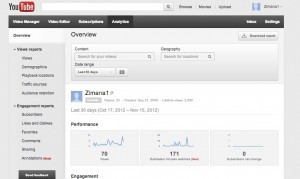
YouTube Analytics is increasingly valuable as YouTube's comments and metrics are increasingly scrutinized
Sometimes redesigning a suite of technological products is like redecorating a house. Once you start with one room, you end with more rooms redecorated to complete a look.
Google was certainly redecorating their house a few years ago. After a revamped Google Analytics solution, along with a search engine updates for mobile search and the even more ballyhooed Google Plus platform, Google released YouTube Analytics, an analytics platform for YouTube managers that replaced Insights and was a significant response for the emergence of increased mobile video viewing in the marketplace.
eMarketer released an article noting the growing rate of mobile video watching. Total US Online viewers reached 158.1 million in 2011 - that’s more than 50% of the US population. In the article, PaulVerna, eMarketer senior analyst, noted the significant sources for the trend.
“Audience growth over the next four years will come from all demographic segments, but it will be more pronounced among preteen children, older boomers and seniors. These groups have traditionally lagged teens and younger adults in their video viewing activity, but the gaps will start to close as the market matures.…”
Add Verna’s statement to YouTube’s current recognition as one of the largest search engines. Mix those points with Google’s introduction of mobile-centric features in its online search engine, and you have a recipe for YouTube Analytics.
You can find my first impression of YouTube Analytics in my All Analytics post. Since that post was issued, a few new protocols have been added to impact the value of YA metrics. Google has focused on requiring YouTube viewers to have a Google account to comment on YouTube videos. Comments are also sorted by relevance than the date posted. The creator of video has higher priority for relevancy, follower by commentators who are signed in a Google Plus account.
The interesting responses has been from YouTube "users" who do not wish to be logged into a Google account to provide their commentary. They are suspicious of Google with respect to privacy and simply do not want to complicate their right to speak anonymously. This CNN post summarizes the complaints. Furthermore, a report from Digital Trends noted that Google uses YouTube "superflaggers" to identify abusive comments.
The comment-clensing strategy is meant for more than reducing off-color comments. The strategy also supports YouTube's increased influence in entertainment as a source for new music or information on movies. Nielsen ratings and Billboard, two long-established measurement agencies in television and music, include YouTube views into their metrics.
From an analytics perspective, this development reflects today's digital effort to clean data sources. To make better sense of the metrics analyzed, data quality is essential. Removing poor comments on YouTube reflects eliminating the "poor data" from comments. Comments can be analyzed for better understanding what videos appeals to customers, though an argument can be made for having an opt-out for those who want to comment and debate without everything on a Google-controlled platform.
Businesses that use YouTube heavily may want to add comments in their privacy policy regarding how their YouTube channel is moderated. This may not win the anti-Google plus-signin crowd, but it can assure those who do check in that the channel is managed in a way that will earn their trust.